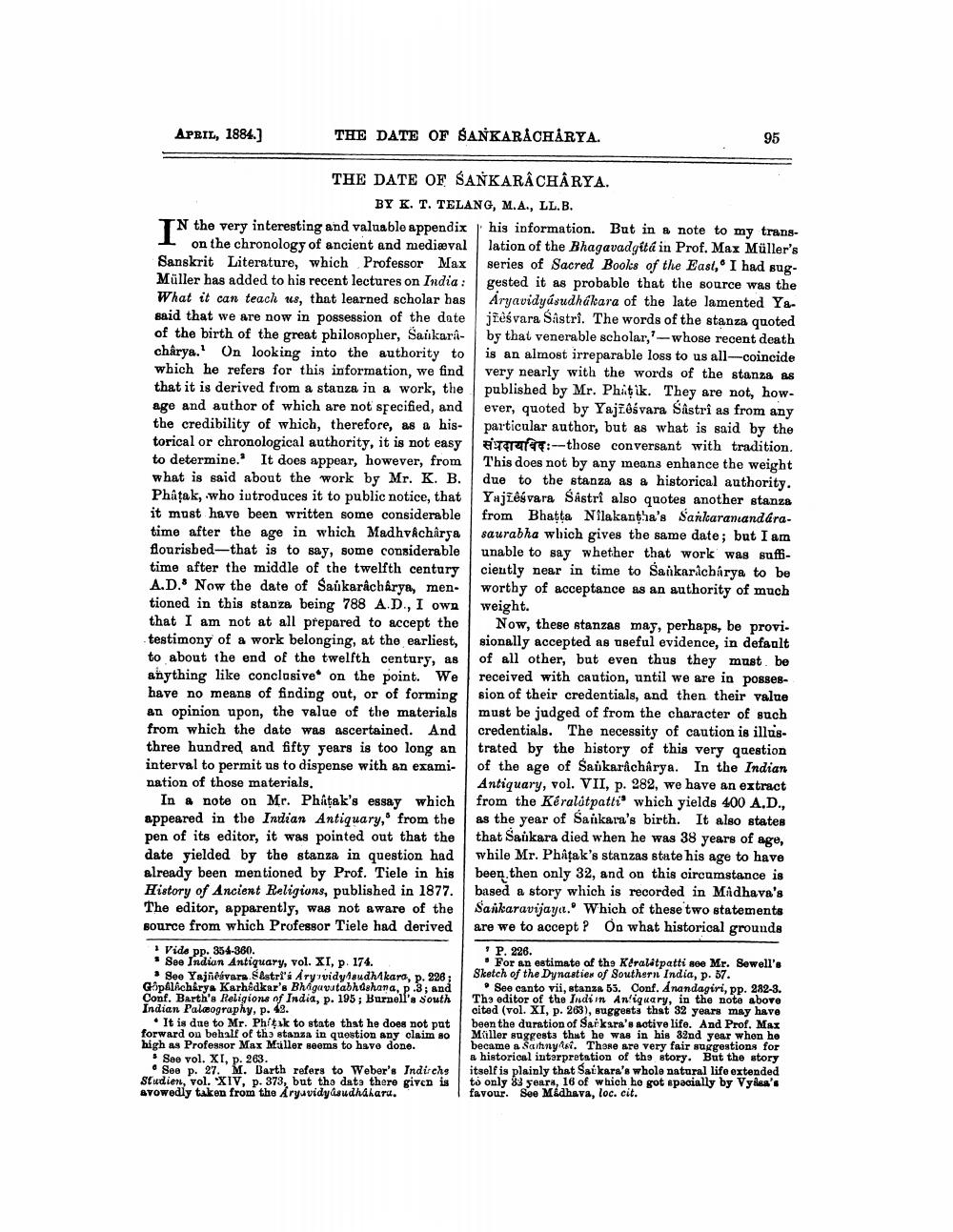________________
APRIL, 1884.)
THE DATE OF SANKARÁCHÅRYA.
THE DATE OF SANKARACHARYA.
BY K. T. TELANG, M.A., LL.B. TN the very interesting and valuable appendix his information. But in a note to my trans1 on the chronology of ancient and medievallation of the Bhagavadgita in Prof. Max Müller's Sanskrit Literature, which Professor Max series of Sacred Books of the East, I had sugMüller has added to his recent lectures on India : gested it as probable that the source was the What it can teach as, that learned scholar has Aryavidyásudháleara of the late lamented Yasaid that we are now in possession of the date jześvara Sastri. The words of the stanza quoted of the birth of the great philosopher, Saukara- by that venerable scholar,'-whose recent death charya.' On looking into the authority to is an almost irreparable loss to us all-coincide which he refers for this information, we find very nearly with the words of the stanza as that it is derived from a stanza in a work, the published by Mr. Phiţik. They are not, howage and author of which are not specified, and ever, quoted by Yajiôśvara Sastri as from any the credibility of which, therefore, as a his- particular author, but as what is said by the torical or chronological authority, it is not easy amarrey:--those conversant with tradition. to determine.' It does appear, however, from This does not by any means enhance the weight what is said about the work by Mr. K. B. due to the stanza as a historical authority. Phatak, .who iutroduces it to public notice, that Yuji.esvara Sastri also quotes another stanza it must have been written some considerable from Bhatta Nilakantha's Sankaranandaratime after the age in which MadhvÂcharya saurabha which gives the same date; but I am flourisbed-that is to say, some considerable unable to say whether that work was suffitime after the middle of the twelfth century ciently near in time to Sankaracharya to be A.D. Now the date of Saukarâchârya, men worthy of acceptance as an authority of much tioned in this stanza being 788 A.D., I own weight. that I am not at all prepared to accept the Now, these stanzas may, perhaps, be provi. testimony of a work belonging, at the earliest, sionally accepted as useful evidence, in default to about the end of the twelfth century, as of all other, but even thus they must be anything like conclusive on the point. We received with caution, until we are in posseshave no means of finding out, or of forming sion of their credentials, and then their value an opinion upon, the value of the materials must be judged of from the character of such from which the date was ascertained. And credentials. The necessity of caution is illuisthree hundred and fifty years is too long an trated by the history of this very question interval to permit us to dispense with an exami- of the age of Saúkaracharya. In the Indian nation of those materials.
Antiquary, vol. VII, p. 282, we have an extract In a note on Mr. Phatak's essay which from the Kéralitpatti' which yields 400 A.D., appeared in the Indian Antiquary, from the as the year of Sankara's birth. It also states pen of its editor, it was pointed out that the that Saukara died when he was 38 years of age, date yielded by the stanza in question had while Mr. Phatak's stanzas state his age to have already been mentioned by Prof. Tiele in his been then only 32, and on this circumstance is History of Ancient Religions, published in 1877. based a story which is recorded in Midhava's The editor, apparently, was not aware of the Sankaravijaya. Which of these two statements source from which Professor Tiele had derived are we to accept ? On what historical grounds Vide pp. 354-360.
· P. 226. * See Indian Antiquary, vol. XI, p. 174.
• For an estimate of the Keralatpatti see Mr. Sewell's See Yajnesvars Sestri's Ary vidyisudhakara, p. 226;
Sketch of the Dynasties of Southern India, p. 57. GopAlichérya KarhAdkar's Bhagavutabhdshana, P.3, and See canto vii, stanza 53. Conf. Anandagiri, pp. 282-3. Conf. Barth's Religions of India, p. 195; Burnellia South The editor of the Indiin Anliquary, in the note above Indian Palcography, p. 42.
cited (vol. XI, p. 263), suggests that 32 years may have • It is due to Mr. Phitak to state that he does not put been the duration of Sarkara's active life. And Prof. Max forward on behalf of tha stanza in question any claim so Müller suggests that he was in his 32nd year when he high as Professor Max Muller seems to have done. became a Sany's. These are very fair suggestions for See vol. XI, p. 263
a historical interpretation of the story. But the story • See p. 27. M. Barth refers to Weber's Indirche itself is plainly that Sai kara's whole natural life extended Studien, vol. XIV, p. 373, but the data there given is to only 83 seara, 16 of which he got spacially by Vyasa's Avowedly taken from the Aryuvidyasudhahari.
favour. See Midhava, loc. cit.




